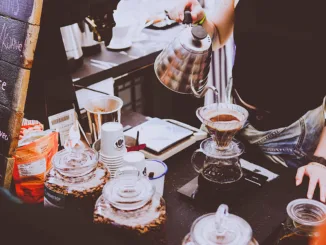
We share our top five strategies for de-escalating conflict in the café.
BY EMILY JOY MENESES
BARISTA MAGAZINE ONLINE
Featured photo sourced via Unsplash
In part one of “Let’s Talk About: Conflict De-Escalation” we explained what conflict de-escalation is and why it’s an important skill for any café worker to develop. Today, in part two of this article series, we’re sharing our top five de-escalation tactics and how to incorporate them into your workplace.
5 Key De-Escalation Tactics for Café Workers to Know
Here are some of the helpful de-escalation tactics I’ve come across through my research on the topic. This is a non-exhaustive list, but it serves as a good starting point as you and your team develop your “soft skills”, or interpersonal skills that help ensure calm, harmonious interactions.
Again, the following list is just a starting point for you and your team to learn conflict de-escalation. Keep conversation open on how you can continue to create a café environment that feels safe and peaceful for everybody involved. And when approaching conflict, remember that everybody is human—and if you approach a situation with compassion, the other person is more likely to do so as well.

1. Create personal space.
When dealing with a customer who’s acting aggressively, it’s important to first create and maintain distance between yourself and them. If other people are involved, gently encourage them to create some distance as well. It could also be helpful to pull the guest aside so that you can speak with them away from the rest of the shop.
2. Maintain relaxed body language and a calm tone of voice.
To de-escalate conflict, it’s important to stay patient and counteract aggression with a sense of calm and centeredness. Instead of matching the person’s feelings of anger and frustration, respond with gentleness. If you find yourself getting heated, you can calm yourself down by taking deep breaths and reminding yourself of your ultimate goal in the situation: to reduce harm.
3. Connect with the person and show empathy while remaining assertive.
Try to create a connection with the person in small ways, such as asking their name and using it when speaking to them. Maintain eye contact and use language that shows you’re trying to understand how the person feels. For example, you can tell the person, “I understand that you’re frustrated about XYZ, and I’m sorry for that. However, I’d appreciate it if you calmed down so that I can better help you.”

4. Avoid accusatory language or commands.
When de-escalating conflict, try to avoid using any language that accuses the person or commands them to do anything. For example, instead of saying, “Sit down,” you can say, “You seem like you need to take a second—would you like to take a seat?”
While it’s tempting to fight fire with fire, being the bigger person and meeting the aggressor with patience and understanding is the best way to ensure the safety of yourself and those around you.
5. Find a resolution that takes both your needs and theirs into account.
Open up discussion with the person to find a solution to the problem that meets both your needs and theirs. You can ask them questions like, “What would make you feel better in this moment?” while also communicating your own needs.
Presenting someone with choices can help soften someone who’s feeling frustrated. For example, you can tell a customer who isn’t satisfied with their beverage, “I can offer to remake or refund your drink—my team is working really hard and I ask that you please be more patient with us.” By presenting choices while expressing your own experience and boundaries, you’re showing them that you’re understanding of their feelings, and they should also be empathetic to yours.

A Café Owner’s Perspective
Zayde Naquib, the original founder of Bar Nine and current owner of Frequency Tea, shares his insight on the topic of de-escalation and how it improved his relationship with his customers.
“As a small-business owner, I was in the unique position to thank the person for the feedback, as most people rarely say anything,” he continues. “I (would try) to redirect things by saying, ‘Small business is tough, as I’m sure you know.’ When these moments work well, the person making the complaint often ends up feeling like their voice mattered and they’re able to step outside of themselves and also have empathy. This is the ideal, as these guests often turn into your biggest advocates.”
Prioritize Peace and Safety
The above list is just a starting point for you and your team to learn conflict de-escalation. Keep conversation open on how you can continue to create a café environment that feels safe and peaceful for everybody involved. And when approaching conflict, remember that everybody is human—and if you approach a situation with compassion, the other person is more likely to do so as well.
ABOUT THE AUTHOR
Emily Joy Meneses (she/they) is a writer and musician based in Los Angeles. Her hobbies include foraging, cortados, vintage synths, and connecting with her Filipino roots through music, art, food, and beverage.
Subscribe and More!
Out now: It’s the August + September 2024 issue of Barista Magazine! Read it for free with our digital edition. And for more than three years’ worth of issues, visit our digital edition archives here.
You can order a hard copy of the magazine through our online store here, or start a subscription for one year or two.





